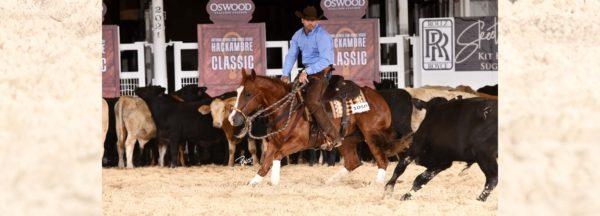Training Tip: Training a Show Horse With the Method

Question: I’m starting a yearling Quarter Horse filly with the Method and will prepare her for competitions such as western pleasure, showmanship and lunge line. I’ve noticed that she has a lack of horsemanship skills and I would like to know how to train her. Do I start the Method exactly like it’s programmed, or do I have to change or avoid some exercises since I’m planning to use her for high levels of competition? – romi55
Clinton’s Answer: The Fundamentals, Intermediate and Advanced levels of the Method provide an excellent foundation from which to continue a horse’s training. All my personal horses, no matter what their career path is—reining, cow horse or trail horses – all go through the three levels of the Method. I’ve spent many years perfecting the order of the exercises and fine-tuning each step of every exercise to get the best result. Once you’ve taken a horse through all three levels, you’ll have a horse that’s respectful, soft, willing and supple. With a horse like that, you can do anything with him. From that point, it’s easy to focus on a specific discipline or competition.
I often tell people to imagine the Method and its progressive levels like building a house. The Fundamentals, the first level of the Method, is the level where, through a series of groundwork and riding exercises, you earn your horse’s respect and trust and prove yourself to be the leader in your relationship. Horses are great followers if you are a great leader.
Think of it as the foundation of a house. I’ll be the first to admit that there’s nothing exciting about a house’s foundation; in fact, it’s the most boring part of the house. It’s also the most important. If a house’s foundation is cracked or uneven, the house is no good. A faulty foundation leads to cracks in the walls, leaks and holes. You can go around and keep patching up each little problem, but it’ll be a constant issue. The bottom line is that it doesn’t matter how fancy the rest of the house is; if the foundation is bad, the whole house is bad. The same is true of your horse. If his foundation is lacking, everything you do with him will be a struggle or impossible because he lacks the knowledge required to progress.
Once you have your horse’s respect and have gotten rid of what I like to call the ugly stuff (pinny ears, bad attitude, overreactiveness, etc.) with the Fundamentals Series, you’re ready to get serious. The second level of the Method will challenge you to demand even more from your horse and continue to build on the progress you’ve already made. The Intermediate Series focuses on gaining even more control of your horse’s feet on the ground and achieving true lightness and suppleness under saddle. Think of the second level of the Method as the framework of our imaginary house – the walls, ceilings, floors and roof. Every decent house needs a solid framework.
The third level of the Method continues to build on the respect, control and communication you established in the Fundamentals and Intermediate Series and improves your horsemanship further. You learn to finesse your application of the Method, increase your confidence in the saddle and have the satisfaction of training a horse that responds to a feather-light touch and is a pleasure to work with.
In that way, the Advanced Series is like the finishing details of our house. It’s the fun stuff. It’s deciding what color you’ll paint the walls, the wallpaper you’re going to hang and the type of floor and cabinets you’re installing. The exercises in the Advanced Series are what we all want to do with our horses – collection, spins, stopping off our seat, two-tracking, etc., but they’re the last thing we work on because without a great foundation and good structure all of these finishing details are useless. It’s impossible to teach a horse to collect at the lope if he doesn’t understand how to give to rein pressure at the standstill and collect at the walk or trot first.
The Professional Series, which includes Colt Starting, Foal Training and Trick Training, is the icing on the cake. You don’t have to know how to start a colt or train a foal or teach a horse to do tricks to be a good horseman, but it is good knowledge to have and fun to do. To follow along with our house-building analogy, this is the stage where you decide to add the hot tub or Jacuzzi. These additions are not necessary for a good house, but they’re fun and give you enjoyment.
Have a horsemanship question or looking for more training tips? Check out the No Worries Club.
